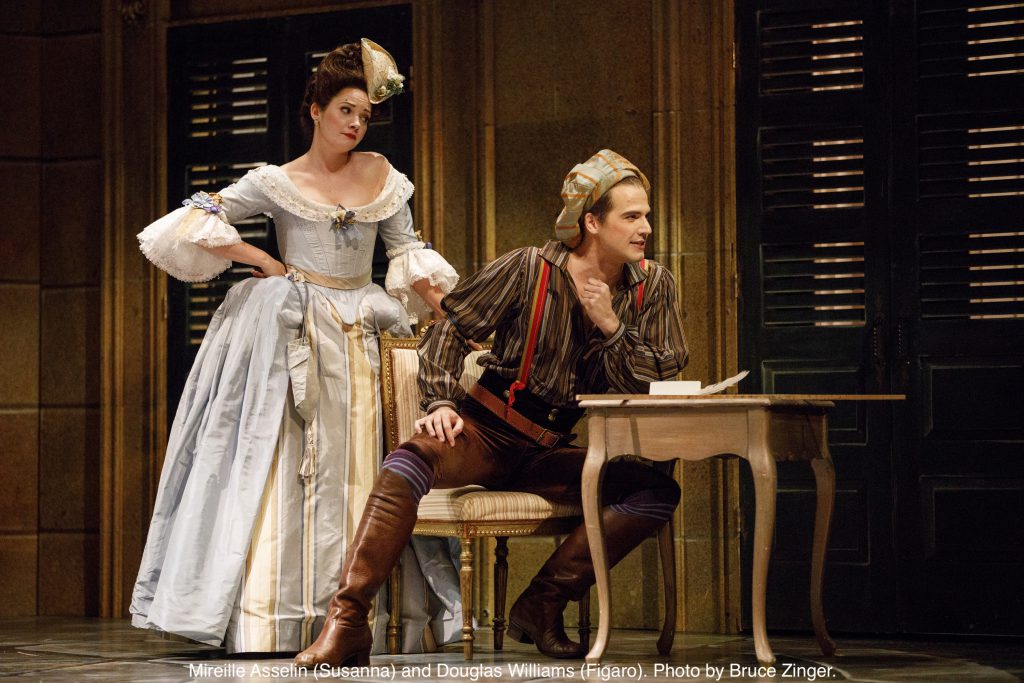Mozart’s cunning factotum was over 200 years old when he and librettist Lorenzo Da Ponte cast him as the star of their subversive 1786 opera buffa, Le nozze di Figaro (The Marriage of Figaro). Playwright Pierre Beaumarchais who had authored a sharply satirical theatrical version, Le Mariage de Figaro, banned in France a decade earlier by a nervous Louis XVI, had provided his Viennese contemporaries with a convenient archetype appropriated from the centuries old commedia dell’arte. Crafty servant Figaro, formerly known as Mezzetino, was the ideal protagonist to spearhead Mozart and Da Ponte’s sly attack on egregious aristocratic manners and privilege. Revolution was in the air. Figaro, with his impeccable comedic pedigree, would lead their stealthy charge.
Launching its 32nd Season of ground breaking historically-informed performance, Toronto’s internationally acclaimed early opera specialist, Opera Atelier, raises the curtain on a freshly reprised iteration of The Marriage of Figaro swirling with wit, dizzily delightful. First presented in 2003, co-artistic directors Marshall Pynkoski and Jeannette Lajeunesse Zingg’s vision of Mozart’s adored masterpiece, viewed through the lens of vibrant period source material, floods the senses, pulsing with life. Theatrical values are as lush as they are expansive.
While enthusiastic purveyors of prevailing Enlightenment ideals, Mozart and Da Ponte were first and foremost entertainers. Popular symbols and forms were consciously incorporated into their work. Audiences would have instantly recognized the host of stock figures and situations embedded in The Marriage of Figaro although it was not until the opera toured to Prague that it began to make serious headway at the box office.
Returning to the commedia dell’arte — it is never truly absent in Opera Atelier’s latest production — a colourful parade of 16th and 17th century-inspired dramatis personæ sweeps across Pynkoski’s quasi 18th century stage. Martha Mann’s costume designs, while somewhat softened versions of Dora Rust-D’Eye’s originals, nevertheless still convey striking resonance.
A pair of elegant Inamorati, represented by the Count and Countess Almaviva, noble lovers here sadly fallen out of love, sumptuously attired in haute couture, are attended by an uproarious troupe of low born Zanni.
Music teacher Basilio and lawyer Don Curzio, the bullying Count’s perennial enablers, are essentially treated as a single player, a black-masked Arlecchino armed with menancing slapstick as commedia convention demanded.
Simply clothed in loose white shirt and baggy pants accompanied by perky straw hat, randy, love-struck Cherubino is given elevated stature, a hopelessly romantic Pierrot.
Big-nosed, over-dressed Dr. Bartolo is every bit the commedia’s pompous Il Dottore, Marcellina, a subtextual stand-in for the character’s customary partner, the libidinous, mercenary-minded Pantalone.
Unlike her classic counterparts, Figaro’s beloved Susanna is presented as very much her own woman in Opera Atelier’s subtly updated presentation, her understated gown only vaguely mirroring her husband-to-be’s striped tunic, far less Mezzetina to Mezzetino than would have been the norm in Mozart and Da Ponte’s day.
As is so often the case with Opera Atelier, historical allegories intentionally hold fast only up to a point. Authenticity is more basic framework than final finished construct here. The paralleling of established characters with pre-existing buffa types transmits enormous energy and originality to this production. Seated row on row surrounded by the gilded opulence of Toronto’s Elgin Theatre, Pynkoski invites us to watch, wide-eyed and excited, as a company of practiced players unveils Mozart’s newly completed masterpiece. Time stops. It is a stunning conceit. The intense theatricality of this ageless Marriage of Figaro boosts music and drama to arguably new heights.
Mozart’s score is a miracle of expression. The wonderment begins with the Prelude. Muted trembling strings suddenly burst into exuberant voice, brass, woodwinds and timpani joining the cheer — a precurser to the unrestrained outpouring of emotion to come. Fury, sadness, lust all is musically revealed. Long threads of meticulous recitative connect the scenes, betrayal to vengeance, reflection to forgiveness. Arias soar. Ensembles magically assemble only to suddenly evaporate and re-form. Duets give way to trios, trios to a sextet, sextet to a final outrageously rowdy coro y tutti.
The Tafelmusik Baroque Orchestra superbly led by conductor David Fallis gives every colour and texture glorious full play. The vividness of tone, the richness of harmony, the sheer joyfulness of this ensemble is quite simply unsurpassed.
Increasingly absent in contemporary productions, resident OA choreographer Lajeunesse Zingg, joined by Artists of Atelier Ballet, returns dance to The Marriage of Figaro restoring all but lost content. Mozart lavished considerable genius purpose-crafting music to extend atmosphere and action at busy moments in the piece. The brisk little Fandango that graces Act III, villagers and gypsies gathered to celebrate Figaro and Susanna’s impending nuptials, is as playful and upbeat as syncopated castanets, folky accompaniment that might well be expected in an opera set in sunny Spain.
Appearing as Seville barber turned valet, bass-baritone Douglas Williams fashions a Figaro of immense charisma and charm. Blessed with a brushed velvet voice and relaxed physicality, the dashing Connecticut-born singer actor maintains unwavering melodic focus from first appearance to last. Figaro’s frisky Act I cavatina, a paean to outrage, Se vuol ballare, Signor Contino, loosely translated as I’ll wipe the smile off his face pretty soon in Opera Atelier’s plainspoken English-language adaptation, utterly enchants.
Singing Susanna, soprano Mireille Asselin brings an equal measure of likeability to her role as opera’s favourite soubrette. Loving and exasperated, caring and cutting — frequently all at once — Asselin steals our hearts and never returns them. A bright, breezy performance not soon to be forgotten.
A frequent visitor to the Opera Atelier mainstage, soprano Peggy Kriha Dye contributes a fine, wistful Countess, her somewhat dark instrument measurably brightening in dual engagements with other principals. Sull’ aria, Mozart’s exquisitely lyrical duet here repurposed as Would you feel the gentle breezes, as performed by Kriha Dye and Asselin spotlights two voices, each every bit as silvery and gleaming as could be wished for.
Bass-baritone Stephen Hegedus is all-conquering as stormy lord of the manor, Count Almaviva. Relentlessly on target, blisteringly passionate, Hegedus delivers what to all appearances is a career-defining performance. My lady, forgive me (Contessa perdono), pleads Almaviva, his lechery finally unmasked. The duet with Rosina that follows, supercharged with hurt and regret, tears at our emotions. Hegedus captures his doomed character in all his frailty, helpless, frightened, his voice reduced almost to a whisper. A remarkable portrait from a remarkable artist.
Mezzo-soprano Mireille Lebel turns in a sparkling Cherubino, all boyish top notes and impetuousness. Tell me what love is (Voi che sapete), the ultimate lover’s love song to love is dispatched with an irresistible blend of runaway intensity tinged with blissful naivety.
Bass-baritone Gustav Andreassen is a suitably blustering Dr. Bartolo. Mezzo Laura Pudwell is eternal plotter Marcellina. Tireless tenor Christopher Enns appears in a taxing double role as a decidedly sinister Basilio/Don Curzio. Olivier Laquerre is an oafish Antonio, the gardener. Grace Lee is his not-so-innocent daughter, Barbarina.
A 13-voice Opera Atelier Chorus powers this Marriage of Figaro’s irrepressibly buoyant chorales.
Like all arts organiztions in the 21st century, successful opera companies are measured by the strength of their brand. With this brilliant, astonishingly unique production, the company proves it has no rivals.


